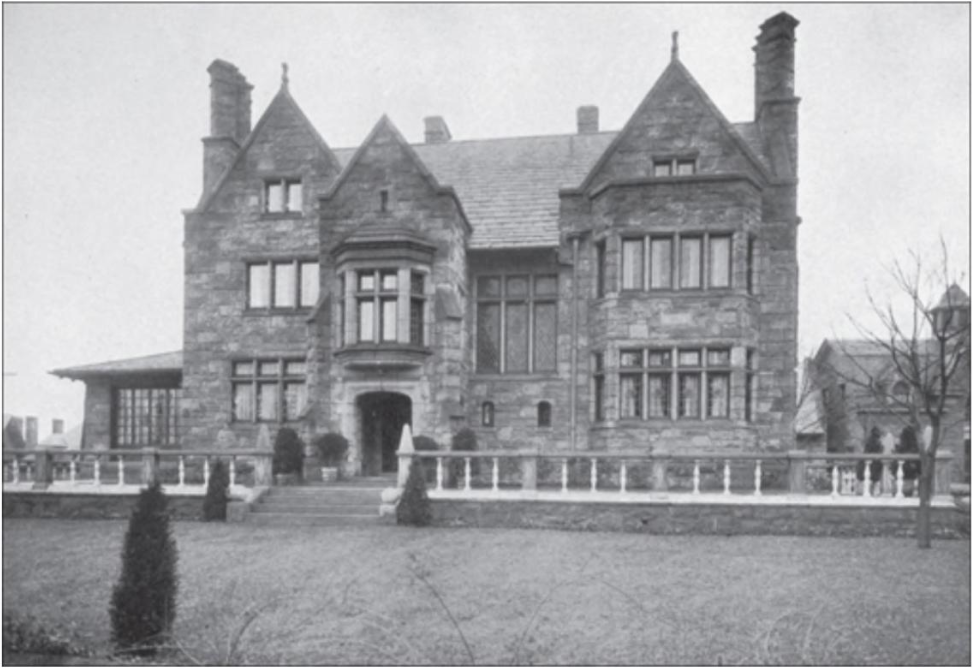Built by powerhouse business tycoons with names like Mellon, Westinghouse, Heinz and Frick, Pittsburgh’s Golden Age mansions tell an important story about the history of Pennsylvania’s Steel City. Notably, these estates tie the city directly back to the earliest days of the booming steel industry that impelled its development. With help from author Melanie Linn Gutowski and her book “Pittsburgh’s Mansions,” let’s take a look at some of the most singular and historic mansions of Pittsburgh.
The Golden Age of Pittsburgh
As Gutowski reports in the introduction of the book, during Pittsburgh’s peak years — roughly 1830 through 1930 — the city housed more millionaires than New York City. Wealthy residents came out of the Western Pennsylvania manufacturing industry, with big companies riding the waves of coal, oil and of course, steel. They built their estates in the center of the city, especially in the historically posh East End — home to the Squirrel Hill, Shadyside and Point Breeze neighborhoods — and out into surrounding areas, like Allegheny City. The influx of wealth and availability of land enabled owners to build expansive, extravagant mansions in and around the city.

- John Worthington’s Squirrel Hill Mansion — At 5505 Forbes Avenue in the East End once sat the historic Squirrel Hill mansion built by South Penn Oil Company executive, John Worthington. Architect Louis Stevens designed the home in a distinctly Jacobean Revival style exterior with English Revival interior. In 1915, Worthington commissioned Stevens to design a new wing with crenellated parapets, a signature feature of Jacobean Revival design. In the book “Squirrel Hill,” the author points out the lavish plasterwork relief, molded-oak wall paneling and ornate decorations that signified Worthington’s wealth. The mansion was acquired by the congregation of Temple Sinai in 1946 and still serves as a synagogue today.
- The B.B. Mellon Residence in Shadyside — Within the East End is Shadyside, a neighborhood in Pittsburgh that boomed in the second half of the 1800s. The rich and powerful built their homes along Shadyside’s Fifth Avenue‚ otherwise known as “Millionaire’s Row.” Among the most famous was the Richard Beatty Mellon and Jennie King Mellon estate, which sat atop a hillside on Fifth Avenue. It boasted elaborate formal gardens and a famous Tiffany mural that’s now owned by the Carnegie Museum of Art. The home’s carriage house now belongs to Phipps Garden Center, and the land is a part of Mellon Park. The old iron gates from the estate still encircle Mellon Park and the Pittsburgh Center for the Arts.
- The H.J. Heinz Greenlawn Estate — Built by condiment king H.J. Heinz, Greenlawn was a grand Penn Avenue mansion surrounded by estates owned by business magnates like Andrew and Thomas Carnegie and George Westinghouse. Those who knew Heinz reported that he was an energetic and ambitious man who often changed the look of the house and filled it with expensive works by French painter Adolphe William Bougureau.
- F.T.F. Lovejoy’s Edgehill Estate — American industrialist Francis Thomas Fletcher Lovejoy amassed considerable wealth during Pittsburgh’s Golden Age, primarily through the creation of the United States Steel Corporation. He built the sprawling estate at Braddock and Edgerton Avenues in Point Breeze with the assistance of famed architecture firm Alden and Harlow around 1905. Though the Edgehill estate is no longer standing, photos indicate that it was one of the most exquisite in all of Point Breeze.
- Clayton at The Frick Pittsburgh — If you want to get a sense of Pittsburgh’s Gilded Age in person, then a visit to The Frick Pittsburgh is in order. Industrialist Henry Clay Frick built the Victorian-style Clayton estate, where he lived with his family between 1883 and 1905, with help from architects Andrew Peebles and Frederick J. Osterling. Now, the stunning Frick mansion is part of the Frick Arts & Historical Center at 7227 Reynolds Street. Museums and lush gardens surround the Clayton, and the restored Victorian mansion is open for public tours six days a week.
- The McCook Estate in Shadyside — Another one of the Golden Age mansions that survived the 20th century is the McCook Estate along Millionaire’s Row, which now serves as a posh hotel called the Mansions on Fifth Hotel. Prosperous Attorney Willis McCook commissioned the 20,000-square-foot, 1906 Tudor and Elizabethan revivalist style estate — which, by the way, cost just $300,000 to build back then — for himself, his wife Mary, and his 10 children. In his book “Pittsburgh’s Shadyside,” author Donald Doherty notes the McCook Estate’s handsome carved stone fireplace and elaborate woodwork in the dining room. You can still see some of the home’s original finishes when you stay at Mansions on Fifth.
- George Westinghouse’s Solitude in Point Breeze — American entrepreneur and engineer George Westinghouse rose to fame after he invented the railway air brake and other major tools for the electrical industry. He — like contemporaries Frick, Heinz and McCook — settled in Pittsburgh’s East End. The city demolished the Second Empire style mansion, Solitude, in 1919 to make way for a new city park called Westinghouse Park. Some believe that Westinghouse and his engineers made ground-breaking electrical discoveries on the property, and that evidence of this is buried deep underneath the park. The rivalry between Westinghouse and Thomas Edison was legendary as they both raced to bring electricity to the country. Westinghouse’s great-grandson, George Westinghouse IV, joked that the site is home to the grave of Thomas Edison, but historical excavations uncovered only intriguing artifacts and no graves.
Want to learn more about Pittsburgh’s Golden Age mansions? Read Gutowski’s book that offers even more rich details of these stunning homes.

